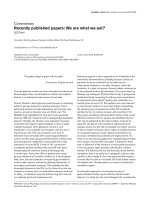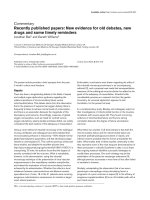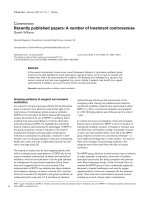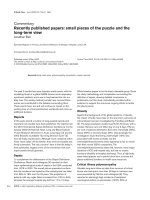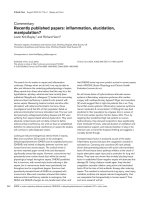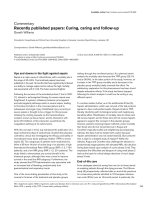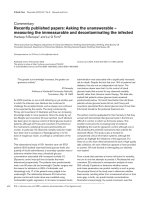Báo cáo khoa học: "Recently published papers: pneumonia, hypothermia and the elderly" pot
Bạn đang xem bản rút gọn của tài liệu. Xem và tải ngay bản đầy đủ của tài liệu tại đây (37.18 KB, 3 trang )
Page 1 of 3
(page number not for citation purposes)
Available online />Abstract
Pneumonia (hospital-acquired and community-acquired) is commonly
encountered in intensive care. Several papers recently published
on this subject have shed more light on different aspects of this
important topic. Hypothermia has been shown to improve post-
arrest outcome, but how often do we use it? And finally, several
papers have recently appeared in the journals related to the
admission of the elderly to the critical care area and their outcome.
Community-acquired pneumonia
Community-acquired pneumonia (CAP) is associated with
considerable morbidity and mortality. Several factors are
associated with a more severe clinical course, for example
increasing age, immunosuppression, and smoking. Recently,
several studies have been published focusing on factors
potentially affecting outcome from CAP.
A publication in Chest [1] prospectively reviewed the
admission characteristics and data obtained during the
hospitalised stay and outcome of 1,347 patients admitted to
a large Spanish teaching hospital. Specifically, the authors
studied the effect of alcohol on the aetiology and severity of
CAP, comparing those with a previous history of alcohol
abuse and those with no history of alcohol abuse. Excluded
groups included those with transplants (solid organ and bone
marrow), HIV and tuberculosis. The most common organism
isolated was Streptococcus pneumoniae regardless of the
group analysed. Disease was more extensive in the alcoholic
group than in the other two groups, as assessed
radiologically (multilobar or bilateral pneumonia). In addition,
the group of patients who were previously alcohol abusers
had a more extensive form of pneumonia than the non-
alcoholics, but this was not as severe as in the alcoholic
group. Other data obtained from this study show that the
alcoholics had an increased requirement for admission to
intensive care and for mechanical ventilation. The durations of
ventilation and hospital stay were more prolonged than for the
non-alcoholic group. The ex-alcoholic data show that they lay
between the other two groups.
The second paper also originates in Spain and assesses the
impact of antibiotic guideline adherence on the duration of
mechanical ventilation for patients with CAP [2]. This
multicentre prospective trial reviewed the data of all patients
admitted to intensive care units and receiving mechanical
ventilation over a 2-year period. Admission criteria were not
standardised, and before entry the patients had to receive at
least 24 hours of mechanical ventilation. The study group
numbered 199 with an average age of 63 years. In 44% of
patients the causative organism was Strep. pneumoniae
followed by Haemophilus influenzae in 10%. For 60% of
patients, antibiotic guidelines in accordance with those of the
American Thoracic Society were followed. The third-
generation cephalosporin and macrolide combination was
followed for 56.7%. Patients with an underlying medical
disorder were less likely to be treated in accordance with the
guidelines. Failure to follow the prescribing guidelines resulted
in an extra 3 days of mechanical ventilation in comparison with
those who followed the guidelines, and the rate of ventilator-
acquired pneumonia (VAP) was similar in the two groups.
Ventilator-acquired pneumonia, mechanical
ventilation and outcome of chronic obstructive
pulmonary disease
The prevalence of VAP remains high, with an appreciable
mortality. Kollef and colleagues [3] performed a prospective
observational study on 398 patients admitted to 20 intensive
care units in North America to assess treatment patterns and
outcome associated with de-escalation therapy. This involves
initial broad-spectrum antibiotic administration followed by
targeted therapy (de-escalation) based on microbiological
cultures and sensivities. Major pathogens were identified in
49% of patients, most commonly methicillin-resistant
Staphylococcus aureus (14.8%) and Pseudomonas
Commentary
Recently published papers: pneumonia, hypothermia and the
elderly
Christopher Bouch and Gareth Williams
University Hospitals of Leicester, Leicester Royal Infirmary, Leicester LE1 5WW, UK
Corresponding author: Gareth Williams,
Published: 5 October 2006 Critical Care 2006, 10:167 (doi:10.1186/cc5049)
This article is online at />© 2006 BioMed Central Ltd
CAP = community-acquired pneumonia; VAP = ventilator-acquired pneumonia.
Page 2 of 3
(page number not for citation purposes)
Critical Care Vol 10 No 5 Bouch and Williams
aeruginosa (14.3%). It is of interest that more than 100
different antibiotic regimens were prescribed as the initial
therapy for VAP, with duration of therapy ranging between 1
and 51 days. There was no de-escalation of therapy in 61%
of patients; de-escalation occurred only in those who had a
major pathogen detected. It is noteworthy that mortality was
lowest in the patients who had de-escalation of therapy
(17%) compared with the ‘no-change’ group (23.7%).
There has always been an association between improved
outcomes and increased case load. Kahn and colleagues [4]
reviewed 20,241 patients who received mechanical
ventilation across 37 hospitals in North America for the
period 2002 to 2003. Not surprisingly, this study showed
improved survival in those units with a large case load of
patients undergoing mechanical ventilation (more than 400
patients per year) than in those with a small number (fewer
than 150). This resulted in a 37% decrease in the adjusted
odds of death. The reasons for this decrease are many but
they include exposure to a greater number of cases; a broad
range of best practice is in place and there is greater
experience in the care of the critically ill patient. The authors
in their discussion hint at regionalisation of intensive care
resources perhaps being the way forward, but not for all and
only for specialist intervention or care.
It is commonplace for patients with chronic obstructive
airways disease (COAD) to be referred for intensive care
management. Little is known of the long-term outcome of
survivors after discharge from critical care. The September
edition of Critical Care Medicine [5] published a review of
the mortality and quality of life of survivors 6 years after
admission to intensive care. A total of 742 patients were
included, of whom 379 required mechanical ventilation. Of
the group receiving mechanical ventilation, 36.7% died in
hospital and 31.4% had died 6 years after discharge; 72%
rated quality of life as worse than at admission.
Therapeutic hypothermia after cardiac arrest
Outcome from cardiac arrest remains poor. The use of
therapeutic hypothermia for cerebral ‘resuscitation’ has been
shown to have a survival benefit in out-of-hospital arrest due
to ventricular fibrillation. Merchant and colleagues [6]
performed a web-based survey of physicians in the USA, the
UK and Finland. These physicians were not exclusive to
critical care but included both cardiologists and emergency
medicine. The survey was anonymous and questioned their
use of hypothermia. Only 17% of surveys were completed
(2,248). In total, 74% of USA responders stated they had
never used hypothermia and 64% of non-USA responders
had never used this treatment. The most common reason for
non-use was the lack of available evidence for benefit from
cooling after arrest. Those who did use hypothermia after
arrest most commonly used cooling blankets (82%) or ice
packs (58%). Invasive cooling with a vascular catheter and
cold fluids was more likely to be used in non-USA areas.
Cooling was instituted for both in-hospital and out-of-hospital
arrest and for varying original arrest rhythms.
For practitioners who work in the UK, an interesting paper
published in Anaesthesia [7] looked at the use of therapeutic
hypothermia in the 256 intensive care units in the UK. A
telephone survey obtained a response rate of 98.4% and,
similarly to the results above, only 28.4% of units use cooling.
Reasons cited for non-use were logistical and a lack of
evidence for benefit from this therapy.
Outcome for elderly patients
The percentage of the population over 65 years of age is
increasing and is predicted to increase further. This will
undoubtedly have an effect on intensive care resources.
Kaarlola and colleagues reviewed the admissions of those
more than 65 years old to an intensive care unit in Finland
and compared these with a group aged less than 65 years
[8]. This cross-sectional study obtained 882 in the over-65
group and 1,827 under 65. Results indicated a shorter length
of stay in intensive care for the elderly compared with the
controls, most over-65 non-survivors dying within a month of
discharge from intensive care (66%). This shorter length of
stay was often associated with a decision to limit treatment.
Unsurprisingly, mortality, at various time points, was higher
among the elderly than in the controls. All elderly patients
with a Sequential Organ Failure Assessment (SOFA) score of
greater than 15 on admission died while on the intensive care
unit. Of the over-65 survivors, 88% felt their quality of life was
as good if not better than before admission, and 97% lived at
home. No difference in mortality or outcome was found for
either acute surgical or medical admission. It is important to
note that the majority of the over-65 patients in this sample
lived independently before their hospital admission and may
therefore be a biased sample.
In a paper in Intensive Care Medicine from The Netherlands
[9], short-term and long-term mortality of the very elderly (age
greater than 80 years) was analysed as a retrospective cohort
analysis. Of 578 patients, mortality for unplanned admission
was 34% for a surgical problem and 37.7% for medical
patients, in contrast with about 10% for a planned surgical
admission. Post-discharge mortality was 26.5% and 29.7%
compared with 4.4%, respectively. At 1 year after discharge,
mortality was 62.1% for surgical patients, 69.2% for medical
patients and 21.6% for planned surgical patients. In keeping
with this theme, in the same journal a paper from France
looked at quality of life and outcome in octogenarians referred
for admission to intensive care [10]. Of 180 patients, 73.3%
were refused admission on the basis of futility of care. Hospital
mortality was 62.5% in those admitted to intensive care. Of
those who survived to hospital discharge, quality of life and
independence 1 year later were subjectively much worse.
Competing interests
The authors declare that they have no competing interests.
Page 3 of 3
(page number not for citation purposes)
References
1. de Roux A, Cavalcanti M, Marcos MA, Garcia E, Ewig S, Mensa J,
Torres A: Impact of alcohol abuse in the etiology and severity
of community-acquired pneumonia. Chest 2006, 129: 1219-
1225.
2. Shorr AF, Bodi M, Rodriguez A, Sole-Violan J, Garnacho-Montero
J, Rello J: Impact of antibiotic guideline compliance on dura-
tion of mechanical ventilation in critically ill patients with com-
munity acquired pneumonia. Chest 2006, 130: 93-100.
3. Kollef MH, Morrow LE, Niederman MS, Leeper KV, Anzueto A,
Benz-Scott L, Rodino FJ: Clinical characteristics and treatment
patterns among patients with ventilator-associated pneumo-
nia. Chest 2006, 129: 1210-1218.
4. Kahn JM, Goss CH, Heagerty PJ, Kramer AA, O’Brien CR, Ruben-
feld GD: Hospital volume and the outcomes of mechanical
ventilation. N Engl J Med 2006, 355: 41-50.
5. Rivera-Fernandez R, Navarrete-Navarro P, Fernandez-Mondejar E,
Rodriguez-Elvira M, Guerrero-Lopez F, Vazquez-Mata G: Six-year
mortality and quality of life in critically ill patients with chronic
obstructive pulmonary disease. Crit Care Med 2006, 34: 2317-
2324.
6. Merchant RM, Soar J, Skrifvars MB, Silfvast T, Edelson DP,
Ahmad F, Huang KN, Khan M, Vanden Hoek TL, Becker LB, et al.:
Therapeutic hypothermia utilization among physicians after
resuscitation form cardiac arrest. Crit Care Med 2006, 34:
1935-1940.
7. Laver SR, Padkin A, Atalla A, Nolan JP. Therapeutic hypothermia
after cardiac arrest: a survey of practice in intensive care units
in the United Kingdom. Anaesthesia 2006, 61: 873-877.
8. Kaarlola A, Tallgreen M, Ville P: Long-term survival, quality of
life, and quality-adjusted life-years among critically ill elderly
patients. Crit Care Med 2006, 34: 2120-2126.
9. de Rooij SE, Govers A, Korevaar JC, Abu-Hanna A, Levi M, de
Jonge E: Short-term and long-term mortality in very elderly
patients admitted to an intensive care unit. Intensive Care Med
2006, 32: 1039-1044.
10. Garrouste-Orgeas M, Timsit JF, Montuclard L, Colvez A, Gattolliat
O, Philippart F, Rigal G, Misset B, Carlet J: Decesion-making
process, outcome, and 1-year quality of life of octogenarians
referred for intensive care unit admission. Intensive Care Med
2006, 32: 1045-1051.
Available online />

